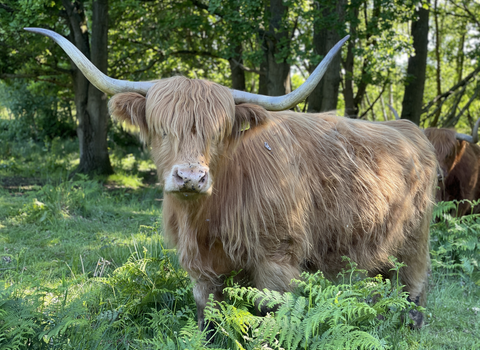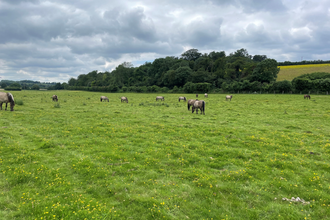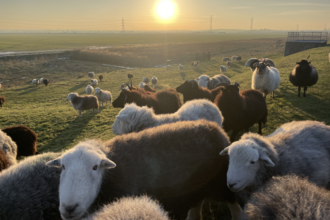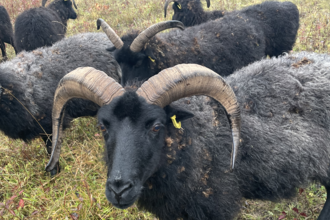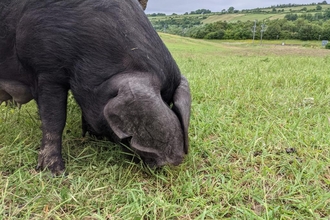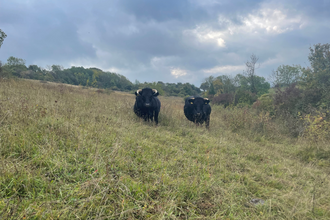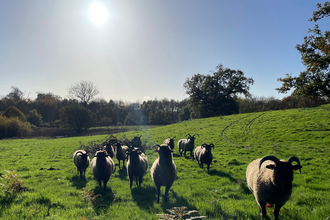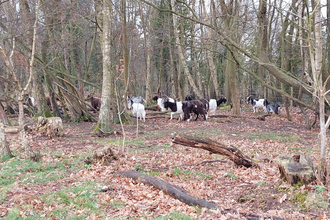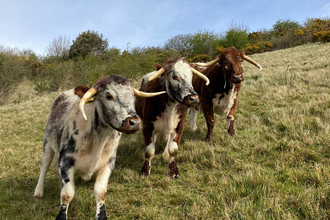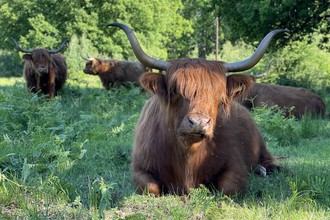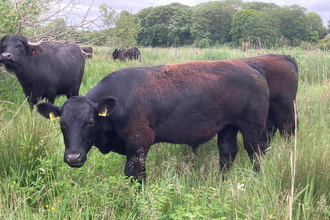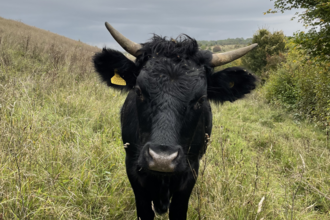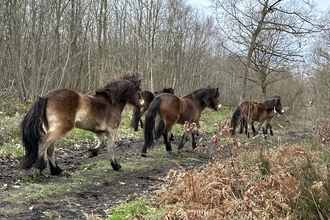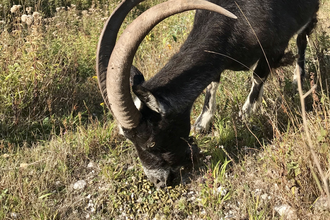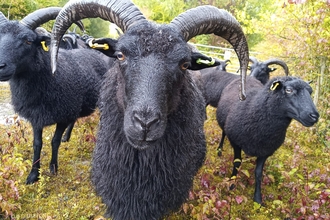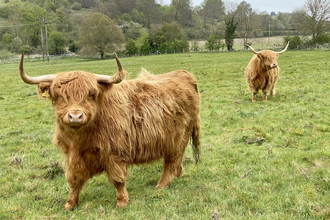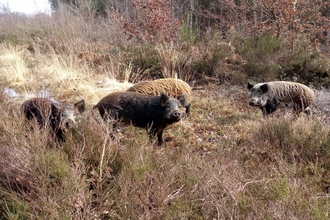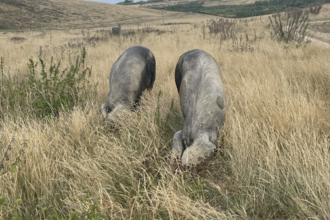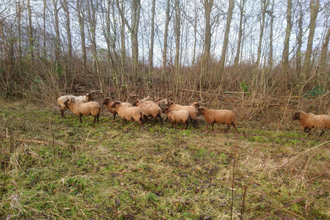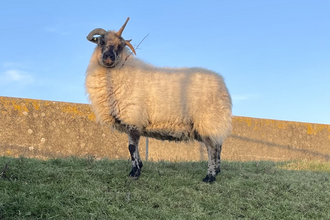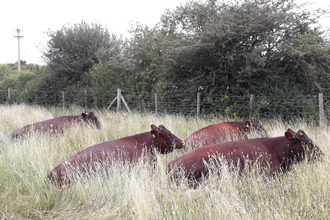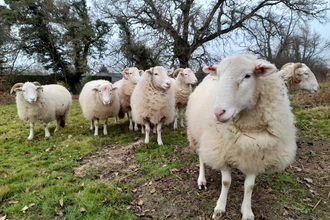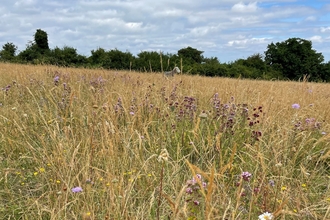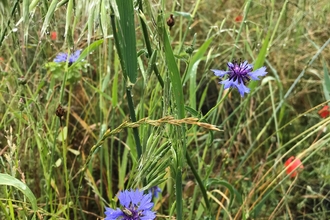Our ground-breaking Wilder Grazing Strategy supports the nature-positive management of our estates, encouraging wildlife recovery and adaptation to the changing climate.
Kent Wildlife Trust is utilising mixes of old breeds of grazing, browsing and rootling animals across all habitats to mimic natural processes. The grazing species on our reserves act in similar ways to the large grazers that used to live wild in Kent but are now extinct, such as auroch, elk and bison.
When used as a conservation tool alongside deer and wild boar, they have an almost symbiotic relationship with their surroundings.
What is a symbiotic relationship?
When there is a mutually beneficial relationship between two different living things.
For instance, when low densities of cattle graze coarse vegetation, it provides room for a wider variety of plants to grow, which in turn gives the cattle a greater choice of food, making them healthier as well as making the habitat more stable and climate-resilient.
Remember to behave responsibly on reserves and keep a minimum 10m distance from grazing animals to support our work and help wildlife recovery in Kent.
Meet some of our current team out on reserves now!
An A - Z of our breeds
Check out our latest updates and events here:
FAQs
How can I help?
- Become a livestock checker - find out more here.
- Give our animals as much room as you can and don't interact with them so they continue with their wild work.
- If you are a dog owner, watch our video here for some tips on training your dog to ignore our animals.
How do you choose which animals to use?
We have a unique reference table that we always use as a starting point, depending on the aims of the site. The knowledge in this table has been gathered from over 150 years of collective experience of our staff, across a multitude of habitats, and from other conservation organisations that have been working on similar projects for the last 20 years or more.
Why use animals, why not just do the job you want done with machines or volunteers?
Although using machinery can be a quick and cheap way to create habitat structure, it doesn't do all the other things that livestock do e.g. dunging, bark rubbing, hosting seeds and insects, fur loss.
Animals can also be much more precise in their work than a machine which tends to excel at straight lines and uniform heights, compared to the mixed mosaic pattern created by animal actions.
Read more about an example of this in our April Blog, Pigs and Wildflowers.
Aren’t cows bad for the environment?
There is a phrase, ‘It’s not the cow, it’s the how’.
Cows have been part of our ecosystems for thousands of years. The climate and biodiversity crises are much more recent (since the industrial revolution).
Cows at natural levels in the environment can support increased nutrient cycling (meaning more carbon is stored in the soils of a grazed grassland than an ungrazed one). They also increase biodiversity by keeping habitat structure mixed, providing a wide range of food and shelter for wildlife.
However, when cows are in intensive systems with lots of food imported into them, and lots of chemical fertilisers, pesticides and antibiotics used to turn them into food for us, that is when they become bad for the environment. The same can be said for all species we use in conservation grazing. Horses, sheep and pigs also create significant environmental harm when kept in artificial and intensive systems.
What types of animals do you have?
Kent Wildlife Trust owns 650 - 800 animals of 17 different breeds and species, including cattle, sheep, goats, ponies, pigs, and water buffalo. Take a look at our breed profiles above to see which animals we use and why.
Are all these grazing animals owned by Kent Wildlife Trust?
We own most of the grazing animals but, on some sites, we work with local farmers and graziers who do our grazing for us. We give them a grazing license which helps to ensure that the site gets the best possible grazing management. In many cases, these are big, grassy sites that need lots of grazing to keep them good for wildlife, and we don’t have enough animals to do that work.
I sponsored a Highland cow, where can I see one in Kent?
We have three herds of highland cattle at the moment: one based at Sandwich and Pegwell Bay, one based in Dover and one in Ashford. Contact us (info@kentwildlife.org.uk) for the most up-to-date locations of our herds.
What’s the difference between what you do and what livestock farmers do?
We do lots of the same things. We have to undertake all the same legal testing, paperwork and welfare care. We breed our own animals. Sometimes we even use the same breeds. Many farmers are now managing their land in ways that are better for wildlife than they were.
There are two main differences:
We graze at very low stocking rates over a wide variety of habitats with old-fashioned breeds.
We might have 10 small hill sheep on 5 ha of grassland, scrub and woodland, whereas a 5ha livestock farm field might have 100 large lowland sheep on it. The way we do it is often uneconomical because the animals grow slower, it can often take longer to do daily welfare checks and it’s harder to catch them if they need treatment.
We also select our animals primarily for temperament rather than size or shape. Almost all our animals are on public sites so we need to make sure that they are relaxed around people. We don’t need to make money from them, so if they don’t breed or aren’t the best shape for meat or milk, for instance, we don’t mind, as long as they are well-behaved and in tune with the habitat.
Why don’t you use local breeds such as Romney sheep?
We do use some local breeds such as the Sussex cattle, however many modern breeds have been encouraged to be over-reliant on grass for their diet. Grasslands make them grow faster than heathland, woodland or downland habitats do. This is great for farmers but we are looking for old-fashioned breeds that are still connected to the wider landscape. These tend to be the upland and mountain breeds that have continued to survive in more natural landscapes, rather than the lowland breeds that now rely more on high-energy foods in lowland grass meadows and flood plains to do well.
Where we have sites that are suitable for lowland breeds, we often use local farmers with those breeds to do the grazing for us, so we can focus on supporting the less popular breeds to work in more difficult habitats
Do your animals stay out all year round?
Yes. Some of our breeding animals come in for short periods of time to have their babies safely and we take sick or injured animals indoors sometimes to treat them.
Other than for the above reasons, our animals stay out all year round. All of our wilder grazing breeds naturally grow warmer coats for the winter, from the famous double coats of the Highland cows, to the thicker, longer hair on the pigs. Exmoor ponies also have specific traits like the area around their eyes and tails that encourages rain to run away from sensitive areas.
Animals use habitats and graze plants in different ways at different times of year, so year-round grazing is an important component of Wilder Grazing.
We had some animals on our local Kent Wildlife Trust site. What happened to them?
It is most likely that they have moved to a different site to do work there. Some habitats only need grazing at certain times of year and some sites are too small to hold a herd or a flock year-round. Where possible, we like to bring the same animals back each year as animals that know a space work better in it than those who don’t.
Sometimes we change the type of animal on site to help with parasite burdens. Mixed grazing is a natural way in which animals in the wild have a reduced worm burden compared to large groups of one type of animal.
A few are sold each year for various reasons and the income goes a small way towards the cost of the herd’s care.
Who should I call if I am worried about your animals?
We have a 24-hour emergency phoneline for livestock that are ill, injured, escaped or at risk of escape: 07796 171 499.
For any non-emergency questions or queries, please contact info@kentwildlife.org.uk
Is it safe to have big animals on nature reserves?
Whenever you are in the countryside, it is important that you keep a safe distance from all large animals. We recommend 10m as a minimum. This is the distance at which our large animals will be able to continue their natural behaviour without feeling pressure from you (other people’s animals may need a greater distance). If in any doubt, give as much distance as you can.
All the large breeds we use have a history of living with people. Sussex and longhorn cattle were used to pull ploughs, Dexters were the original ‘house cow’ – small enough to fit in a house. Koniks worked on farms, and Fell ponies hauled goods over the mountains of Cumbria. This history of living closely with people means that the breeds tend to be calmer and more relaxed around people and the weird things we do (in their minds).
Our animals are also temperament-tested before they go out onto a public site.
Our home-bred animals are introduced to the things they will see out on reserves for about a year once they have left their mums before going out onto sites with the public on them.
Adult animals we buy in are checked for temperament before they are bought and are held for at least two weeks before going into public spaces. Once out, they are checked every day by our trained staff and volunteers who report any changes in behaviour. On the very rare occasion that one of our animals shows any unprovoked aggression, they are immediately removed from our herds.
How do you make sure your animals are healthy and happy when they are living wilder?
All of our animals have a daily welfare check carried out by our amazing team of volunteers and staff. They are supported by dedicated key staff and a specialist grazing manager who has a huge amount of experience with commercial stock management, health, care, nutrition and breeding. This takes care of their physical health to a high standard.
Consideration of mental health and wellbeing has also made progress in the animal world. Allowing our animals to remain in stable family-type groups, giving them free choice in food, shelter and friendship bonds, and allowing them to behave as naturally as possible with minimal human interactions are all things that we know are extremely good for mental health. Allowing the animals to be themselves and have choices is important for them, just as it is for us and this is the cornerstone of the Wilder Grazing approach.
